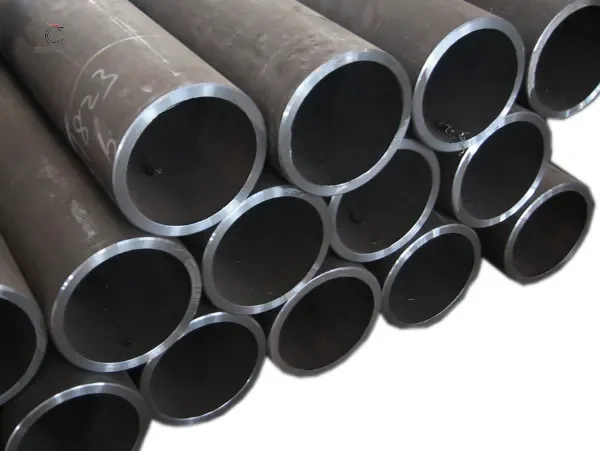Straight steel pipe high-frequency welding process
1.straight seam steel pipe weld gap
The strip is fed into the welded pipe unit, rolled by multiple rolls, the strip is gradually rolled up, forming a circular billet with a gap between the teeth, adjust the amount of squeeze roller pressure, so that the weld gap is controlled at 1 to 3mm, and make the ends of the weld flush. If the gap is too large, the formation of proximity effect is reduced, the lack of vortex heat, the weld crystal between the poor and produce unfused or cracked. If the gap is too small, the formation of the proximity effect increases, welding heat is too large, the formation of weld burn; or weld by extrusion, rolling after the formation of deep pits, affecting the quality of the weld appearance.
2.straight seam steel pipe welding temperature
Welding temperature is mainly affected by high-frequency eddy current thermal power, according to the formula, high-frequency eddy current thermal power is mainly affected by the current frequency, eddy current thermal power is proportional to the square of the current encouragement frequency; and the current encouragement frequency is affected by the encouragement voltage, current and capacitance, inductance. Encouragement frequency formula is: f=1/[2π(CL)1/2]... Where: f-encouragement frequency (Hz); C-encouragement circuit capacitance (F), capacitance = power / voltage; L-encouragement circuit inductance, inductance = magnetic flux / current
The above formula shows that the encouragement frequency is inversely proportional to the square root of the capacitance and inductance in the encouragement circuit, or proportional to the square root of the voltage and current, and only needs to change the capacitance, inductance or voltage and current in the circuit to change the size of the encouragement frequency, so as to achieve the purpose of controlling the welding temperature. On low carbon steel, welding temperature control in 1250 ~ 1460 ℃, can meet the wall thickness of 3 ~ 5 mm weld through the request. In addition, the welding temperature can also be completed by regulating the welding speed.
When the input heat is lacking, the edge of the heated weld does not reach the welding temperature, the metal tissue still adheres to the solid state, constituting an unfused or unwelded; when the input heat is lacking, the edge of the heated weld beyond the welding temperature, resulting in overburning or melt drops, so that the weld constitutes a melt hole.
3.straight seam steel pipe squeezing pressure
The two edges of the pipe billet is heated to the welding temperature, under the extrusion of the extrusion roller, constituting a common metal grain mutual penetration, crystallization, and finally constitute a solid weld. If the squeezing pressure is too small, the number of common crystals constitute a small weld metal strength decline, the force will produce cracking; if the squeezing pressure is too large, will make the molten state of the metal is squeezed out of the weld, not only reduces the strength of the weld, and will produce a large number of internal and external burrs, and even the formation of defects such as welding lap.
4.high-frequency induction circle position control
High-frequency induction circle should be as close as possible to the location of the extrusion roller. If the induction circle is far from the extrusion roller, the effective heating time is longer, the heat-affected zone is wider, and the weld strength falls; conversely, the weld edge heating lack, extrusion after poor molding.
5.impedance
Impedance is a special magnetic rod or a group of welded pipe, impedance of the cross-sectional area should usually be not less than 70% of the cross-sectional area of the inner diameter of the steel pipe, its role is to make the induction circle, the edge of the billet weld and the magnetic rod constitute an electromagnetic induction loop, the proximity effect, eddy current heat concentration in the billet weld edge left, so that the edge of the billet heated to welding temperature. The impedance is dragged inside the billet with a steel wire, whose center position should be relatively fixed close to the center of the extrusion roll. When the machine is turned on, due to the rapid movement of the billet, the impedance device is subject to the friction of the inner wall of the billet and the loss is large, and needs to be changed frequently.
6.welding scars purging
Welding seam by welding and extrusion will produce welding scars, the need to purge. The purging method is to fix the tool on the frame and rely on the rapid movement of the welded pipe to scrape the weld scars flat. The burr inside the welded tube is not usually purged.







